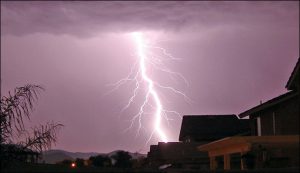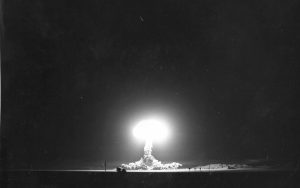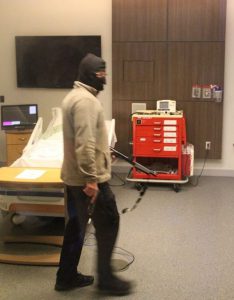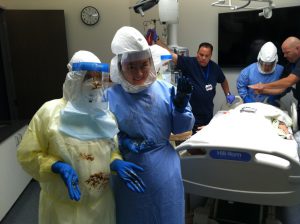Archive for the ‘Drills/exercises’ Category
Take-aways from Event 201
Friday, January 24th, 2020
|
|
Personal Health Preparedness: CDC
Sunday, September 8th, 2019A major public health emergency like a hurricane or a lengthy power outage can limit your access to supplies and services for several days, weeks, or even months. Be prepared with safe water and food, basic supplies, and the personal items you need to protect your health in an emergency.
Personal Needs:
- An emergency water supply.
- Nonperishable and ready-to-eat food, including specialty foods—such as nutrition drinks and ready-to-feed formula—for infants, and people with dietary restrictions, food allergies and sensitivities, and medical conditions such as diabetes.
- Home use medical devices and assistive technologies devices, such as hearing aids, contact lenses, and contact lens solution.
- Medical supplies.
- First aid supplies.
- For more essentials, click here.
Prescriptions:
- A 7- to 10-day emergency supply of essential or priority medications stored in a waterproof, childproof container.
- An up-to-date list, including
- All prescription medications, including dosage amounts and the names of their generic equivalents
- Medical supply needs
- Known allergies
- Nonprescription drugs, including pain and fever relievers, diuretics, antihistamines, and antidiarrheal medications stored in childproof containers.
- For more information on prescriptions, click here.
Paperwork:
- Copies of insurance cards and medical records, including
- Health insurance card
- Immunization and vaccination records
- Vital records (e.g., birth and death certificates and adoption records) and personal identification, including
- Passport
- Driver’s license
- Social Security card
- Copies of current medical emergency plans, such as advance directives and asthma action plans.
- For more information on paperwork, click here.
Power Sources:
- A flashlight or head lamp.
- Extra batteries in standard sizes, such as AA and AAA.
- Car charger(s) and adapters for electricity-dependent equipment and devices.
- A generator with at least 20 feet of extension cord(s).
- Battery-powered smoke alarms and carbon monoxide (CO) detectors.
- For more power sources, click here.
Practical Skills:
- Learn the right way to wash your hands. Handwashing is one of the best ways to protect yourself, your family, and others from getting sick.
- Learn how to use a portable generator safely to prevent CO poisoning.
- Learn how to create and store an emergency water supply.
- For more practical skills, click here.
CDC: Personal provisions, supplies, and equipment necessary to protect the health and safety of your family in an emergency.
Tuesday, April 9th, 2019The Basics
- Water
- Store at least 1 gallon of water per day for each person and each pet. You should consider storing more water than this for hot climates, for pregnant women, and for persons who are sick.
- Store at least a 3-day supply of water for each person and each pet. Try to store a 2-week supply, if possible.
- Observe the expiration date for store-bought water. Replace non-store bought water every 6 months.
- Store a bottle of unscented liquid household chlorine bleach (label should say it contains between 5-6% and 8.25% of sodium hypochlorite) to disinfect your water, if necessary, and to use for general cleaning and sanitizing.
- Nonperishable and ready-to-eat food, including special foods—such as nutrition drinks and ready-to-feed formula—for infants, people with dietary restrictions, food sensitivities and allergies, and medical conditions such as diabetes.
- Prescription eyeglasses, contact lenses, and contact lens solution.
- Assistive technologies, such as hearing aids and picture boards.
- Medical alert identification bracelet or necklace
- Health protection supplies, including insect repellentExternal, water purification tablets, and sunscreen.
- A change of clothes
- Medical equipment including:
- Canes, crutches, walkers, and wheelchairs
- Nebulizers
- Oxygen equipment
- Blood sugar monitors
- Medical supplies, including:
- Antibacterial wipes
- Catheters
- Syringes
- Nasal cannulas
- Blood test strips
- First aid supplies, including:
- First aid reference
- Non-latex gloves
- Digital thermometer
- Waterproof bandages and gauze
- Tweezers and scissors
- A Stop the Bleed kit, including a tourniquet
- Sanitation and hygiene items, including:
- Soap
- Hand sanitizer
- Sanitizing wipes
- Garbage bags and plastic ties
- Toilet paper
- Feminine hygiene supplies
- Pet supplies
- Childcare supplies
- Baby supplies
Social Media Reactions to an Errant Warning of a Ballistic Missile Threat
Friday, February 22nd, 2019Murthy BP, Krishna N, Jones T, Wolkin A, Avchen RN, Vagi SJ. Public Health Emergency Risk Communication and Social Media Reactions to an Errant Warning of a Ballistic Missile Threat — Hawaii, January 2018. MMWR Morb Mortal Wkly Rep 2019;68:174–176. DOI: http://dx.doi.org/10.15585/mmwr.mm6807a2.
“……A total of 127,125 tweets were identified; after excluding 69,151 (54%) retweets and 43,444 (34%) quote tweets, 14,530 (11%) initial tweets remained for analysis. Among these, 5,880 (40%) were sent during the early period, and 8,650 (60%) were sent during the late period……”
* 8:07–8:45 a.m. Hawaii Standard Time.
† 8:46–9:24 a.m. Hawaii Standard Time (additional themes identified in addition to those in the early period).
What is already known about this topic?
Social media platforms are widely used to share information and disseminate alerts and warnings.
What is added by this report?
After an errant ballistic missile alert, social media reactions revealed how the public interprets, shares, and responds to information during an evolving threat. This knowledge can guide emergency risk communicators to develop timely and effective social media messages than can protect lives.
What are the implications for public health practice?
Social media can be an effective tool to send urgent messages during a public health emergency. Public health practitioners need to improve messaging during emergency risk communications to address the public’s needs during each phase of an unfolding crisis to protect and save lives
Active Shootings in Hospitals: Room for improvement
Sunday, December 2nd, 2018Video supports Secure, Preserve, Fight over Run, Hide, Fight in specific healthcare venues
Thursday, November 29th, 2018Active Shooter & Hockey Pucks
Thursday, November 29th, 2018“…… to fight effectively, faculty and students need to be prepared to throw objects that are heavy and will cause a distraction.
Hockey pucks provide the ability to be carried in brief cases or backpacks, are not considered a weapon, and will meet the goal of distracting the shooter, according to Gordon.
Currently, the union has distributed the pucks to its 800 members and is working with student groups to distribute an additional 1,700 pucks to students……..”

Synthetic Bioterrorism: New genetic tools are making it easier and cheaper to engineer viruses and bacteria in the lab and potentially making them more contagious and lethal.
Sunday, July 29th, 2018Biodefense in the Age of Synthetic Biology: http://nap.edu/24890
ISBN 978-0-309-46518-2 | DOI 10.17226/24890
Committee on Strategies for Identifying and Addressing Potential Biodefense
Vulnerabilities Posed by Synthetic Biology; Board on Chemical Sciences and
Technology; Board on Life Sciences; Division on Earth and Life Studies;
National Academies of Sciences, Engineering, and Medicine
One danger is making existing bacteria or viruses more dangerous by giving them antibiotic resistance or altering them so that they produce toxins or evade vaccines.
“…..in a table-top exercise conducted last month by the Johns Hopkins Center for Health Security…..experts in pandemic response and national security grappled with a fictional virus called “Clade X” that was created by a terrorist group that inserted genetic elements of deadly Nipah virus into a normally-mild human parainfluenza virus.
The terrorist group in this scenario wanted to depopulate the Earth, and deliberately released the contagious virus at multiple spots around the globe. The resulting pandemic killed 150 million people within a year as officials struggled to contain the social and economic chaos until a vaccine could be made…….”
National Level Exercise (NLE) 2018 to examine the ability of all levels of government, private industry, and nongovernmental organizations to protect against, respond to, and recover from a major Mid-Atlantic hurricane.
Monday, May 14th, 2018FEMA
National Level Exercise

The Federal Emergency Management Agency (FEMA) leads national-level exercises every two years. National Level Exercise (NLE) 2018 will examine the ability of all levels of government, private industry, and  nongovernmental organizations to protect against, respond to, and recover from a major Mid-Atlantic hurricane. The scenario involves a major hurricane that makes landfall near Hampton Roads, Virginia, causing severe damage to residences, businesses, and critical infrastructure throughout the Mid-Atlantic. Hurricanes Harvey, Irma, and Maria last fall reinforced our need to prepare for hurricanes, and NLE 2018 provides a well-timed opportunity to apply lessons from those storms in advance of the 2018 Atlantic hurricane season, which begins on June 1.
nongovernmental organizations to protect against, respond to, and recover from a major Mid-Atlantic hurricane. The scenario involves a major hurricane that makes landfall near Hampton Roads, Virginia, causing severe damage to residences, businesses, and critical infrastructure throughout the Mid-Atlantic. Hurricanes Harvey, Irma, and Maria last fall reinforced our need to prepare for hurricanes, and NLE 2018 provides a well-timed opportunity to apply lessons from those storms in advance of the 2018 Atlantic hurricane season, which begins on June 1.
Get Involved
There are many ways for individuals, businesses, and community organizations to participate in NLE 2018 and get better prepared for hurricanes. If you live or do business in an area vulnerable to hurricanes, it is important that you understand your risk, develop a preparedness and mitigation plan, and take action. Find resources to prepare for hurricanes below. Fact Sheets can be downloaded from anywhere you see this icon ![]() or by clicking on the hyperlink.
or by clicking on the hyperlink.
 For Individuals
For Individuals
Threats from hurricanes include high winds, heavy rainfall, storm surge, coastal and inland flooding, rip currents, and tornadoes. The heavy winds of hurricanes can cause damage or destroy homes, buildings, and roads, as well as cause power, water, and gas outages. Watch FEMA’s “When the Waves Swell” video to understand your hurricane risk, then learn how to take action below.
 Get Alerts and Warnings
Get Alerts and Warnings
Receiving timely information about weather conditions or other emergency events can make all the difference in knowing when to take action to be safe.
- Download the FEMA App to learn what to do before, during, and after emergencies, and receive weather alerts from the National Weather Service for up to five different locations anywhere in the United States.
- Read FEMA’s Know Your Alerts and Warnings guide.
- Visit your local county emergency management website to learn more about what notifications are available in your community.
 Create and Test a Family Communication Plan
Create and Test a Family Communication Plan
Make a plan today. Your family may not be together if a disaster strikes, so it is important to know which types of disasters could affect your area. Know how you’ll contact one another and reconnect if separated. Establish a family meeting place that’s familiar and easy to find.
- Get started on your plan at www.ready.gov/make-a-plan.
- Use FEMA’s Family Communication Plan sheet to help your family practice and remember your plan.
- Print Family Emergency Communication Plan Wallet Cards to put in your child’s backpack or car glove compartment.
 Document and Insure Property
Document and Insure Property
When a disaster strikes, having insurance for your home or business property is the best way to ensure you will have the necessary financial resources to help you repair, rebuild, or replace whatever is damaged.
- Get started with FEMA’s Document and Insure Your Property guide.
- Consider buying flood insurance. Individuals can purchase flood insurance through an insurance agent or an insurer participating in the National Flood Insurance Program (NFIP). If your insurance agent does not sell flood insurance, you can contact the NFIP Referral Call Center at 1-800-427-4661 to request an agent referral.
- Visit www.FloodSmart.gov to learn more about purchasing flood insurance and the National Flood Insurance Program.
 Strengthen Your Financial Preparedness
Strengthen Your Financial Preparedness
Know your disaster costs. Taking the time now to collect and secure personal financial, insurance, medical, and other records will give you peace of mind and, in the event of an emergency, will ensure that you have the documentation needed to start the recovery process without delay.
- Download FEMA’s Emergency Financial First Aid Kit for more information.
- Visit mymoney.gov to learn how to save, invest, and get insured for your financial future.
 Get Trained
Get Trained
Minutes matter in a disaster, and if emergency responders aren’t nearby, you can be the help until help arrives. There are many ways to get involved in your community.
- Visit ready.gov/until-help-arrives for online training and to find out what your role can be during disasters.
- Contact your local emergency management office to find upcoming training, discussions, and events in your community.
![]() Download the Individuals Fact Sheet
Download the Individuals Fact Sheet
 For Businesses
For Businesses
Preparing for hurricanes and developing a plan will increase the safety of employees and customers and help you remain in business after disaster strikes. Maintaining business continuity is important. When you are able to continue operations after a disaster, you also improve your community’s ability to recover.
 Participate in National Level Exercise 2018
Participate in National Level Exercise 2018
Over 200 organizations, including all levels of government, private businesses, and nonprofit organizations, will participate in NLE 2018. Private sector participants should focus their play on May 3 and May 8-10, 2018. Participation options are available for all levels of play and businesses of all sizes. Businesses can also participate through National, Regional, and State Business Emergency Operations Centers.
 The functional and full-scale portions of NLE 2018 will occur between April 30 and May 11, 2018.
The functional and full-scale portions of NLE 2018 will occur between April 30 and May 11, 2018.
Private sector participants should focus their play on NBEOC call dates (May 2-4 and May 7-9) and targeted private sector play (May 7-9). Participants from the infrastructure sector are encouraged to focus their play on May 8.
- Contact nle@fema.dhs.gov to learn more about your options for participating in NLE 2018.
NLE 2018 Private Sector Capabilities and Objectives
Private and infrastructure sector participants will focus on testing the following capabilities during NLE 2018:
- Information Sharing: Test the use of a benchmarking system to self-assess information sharing situational capabilities based on the U.S. Department of Homeland Security (DHS) Incident Management Information Sharing (IMIS) Capability Maturity Model (CMM), as well as the ability to provide updates to the community regarding the status of operations.
- Request, Acquisition, and Movement of Resources: Test the ability to identify and coordinate delivery of resources from private-to-government, government-to-private, and private-to-private requests, as well as the ability to transport resources through waivers and exemptions.
- Business Emergency Operations Center (BEOC) Capabilities: NLE 2018 will test and evaluate the coordination capabilities of State, Regional, and National BEOCs.
Private sector participants are invited to set their own exercise objectives as they align to one of the following three categories:
- Organization-Led: The objective is specific to what an individual company or organization wishes to achieve during the exercise.
- Market-Segment: The objective is specific to a group of organizations or companies, such as small businesses, telecommunications companies, healthcare networks, or electric utilities.
- Cross-Sector: The objective is specific to a group of market segments or sectors and aligned to interdependencies between those markets and/or sectors.
 Conduct an Exercise Internal to Your Business
Conduct an Exercise Internal to Your Business
Conduct an exercise on your own using the NLE 2018 Exercise Starter Kit. This starter kit is an “exercise in a box,” and includes exercise templates, a detailed scenario, discussion questions, and scene-setting videos to help your business prepare for hurricanes.
 Get Your Business Hurricane Ready
Get Your Business Hurricane Ready
Significant portions of the United States are at risk for the effects of tropical storms and hurricanes. It is important that organizations throughout the country, including associations, businesses, and community groups, understand the risks and potential impacts and prepare accordingly.
- Download the Hurricane Ready Business Toolkit and take action to protect employees, protect customers, and help ensure business continuity for hurricanes and tropical storms.
- Visit www.ready.gov/business for more information.
 Join the National Business Emergency Operations Center
Join the National Business Emergency Operations Center
The National Business Emergency Operations Center (NBEOC) is FEMA’s virtual clearinghouse for two-way information sharing between public and private sector stakeholders in preparing for, responding to, or recovering from disasters. Participation in the NBEOC is completely voluntary and open to all members of the private sector with a national footprint.
- Email FEMA-Private-Sector@fema.dhs.gov for more information on joining.
 Spread the Preparedness Message with Your Employees and Customers
Spread the Preparedness Message with Your Employees and Customers
Help spread the word by sharing hurricane preparedness products with your employees and customers.
- Share hurricane preparedness resources like our How to Get Involved fact sheet, which covers how to get alerts, insure property, strengthen your financial preparedness, and more.
- Visit www.ready.gov/hurricanes for more information to share with your audience.
 Download the Private Sector and Infrastructure Fact Sheet
Download the Private Sector and Infrastructure Fact Sheet
 For Community Organizations
For Community Organizations
Preparing for hurricanes and developing a plan will increase the safety of your membership and help your organization remain open after disaster strikes. When you are able to continue operations after a disaster, you also improve your community’s ability to recover.
 Spread the Preparedness Message with Your Membership
Spread the Preparedness Message with Your Membership
Help spread the word to your membership, partners, and immediate community.
- Share hurricane preparedness resources like our How to Get Involved fact sheet, which covers how to get alerts, insure property, strengthen your financial preparedness, and more.
 Get Your Organization Hurricane Ready
Get Your Organization Hurricane Ready
Significant portions of the United States are at risk for the effects of tropical storms and hurricanes. It is important that organizations throughout the country understand the risks and potential impacts and prepare accordingly.
- The Prepare Your Organization for a Hurricane Playbook is designed to provide community leaders with the tools and resources to hold a preparedness discussion and tabletop exercise to test their plans, policies, and procedures for a disaster.
- Visit www.ready.gov/hurricanes for more information.
 Engage with National Level Exercise 2018
Engage with National Level Exercise 2018
Over 200 organizations, including all levels of government, private businesses, and nonprofit organizations, will participate in NLE 2018 between April 30 and May 11, 2018. Organizations of all sizes can participate by attending a national webinar on Hurricane Preparedness on Tuesday, May 8, 2018 from 2:00 p.m. to 3:00 p.m. EDT.
- To RSVP for the webinar, e-mail Partnerships@fema.dhs.gov with “Hurricane Webinar” in the subject line.
- You can also get involved by conducting an exercise on your own using the NLE 2018 Exercise Starter Kit. This starter kit is an “exercise in a box,” and includes exercise templates, a detailed scenario, discussion questions, and scene-setting videos to help your organization prepare for hurricane season.
 Join the National Voluntary Organizations Active in Disasters (NVOAD)
Join the National Voluntary Organizations Active in Disasters (NVOAD)
National VOAD is an association of organizations that mitigate and alleviate the impact of disasters; provide a forum promoting cooperation, communication, coordination, and collaboration; and foster more effective delivery of services to communities affected by disaster.
- Learn more and join the movement at www.nvoad.org.
 Download the Community Organizations Fact Sheet
Download the Community Organizations Fact Sheet
 For Government
For Government
If your department or agency is not yet participating in NLE 2018 and is interested in joining, please contact nle@fema.dhs.gov to learn more about your options for participation.
 About the National Level Exercise
About the National Level Exercise
A number of local, state, and federal exercises have been integrated into NLE 2018 which include: Atlantic Fury FEMA Region III (DC, VA, MD, PA, DE, WV), Vigilant Guard 18-3 (Virginia National Guard Bureau), Vigilant Guard 18-4 (Maryland National Guard Bureau), Eagle Horizon (FEMA National Continuity Programs), Clear Path (U.S. Department of Energy), Ardent Sentry (U.S. Northern Command), Citadel Gale/HURREX (U.S. Navy), Fifth District Hurricane Exercise (U.S. Coast Guard), and the U.S. Army Corps of Engineers Hurricane Exercise.
A common exercise scenario and control environment will bring together each of these components into one unified exercise.
 NLE 2018 Objectives
NLE 2018 Objectives
NLE 2018 consists of four overarching exercise objectives:
1. Pre-landfall Protective Actions:
Examine and validate the capabilities of federal, state, local, tribal, and territorial governments, as well as private industry, nongovernmental organizations, community organizations, and members of the public, to take coordinated and inclusive protective actions prior to a projected major hurricane landfall in accordance with applicable plans, policies, and procedures.
2. Sustained Response in Parallel with Recovery Planning:
Demonstrate and assess the ability of federal, state, local, tribal, and territorial governments, in coordination with private sector, philanthropic, and nongovernmental partners, to conduct inclusive post-hurricane landfall response operations and simultaneously conduct inclusive recovery planning activities.
3. Continuity in a Natural Disaster:
Demonstrate and assess the ability of federal and non-federal government organizations to implement continuity plans and perform essential functions appropriate for incident conditions to sustain National Essential Function (NEF) 6.
4. Power Outages and Critical Interdependencies:
Examine and validate the capabilities of federal, state, local, tribal, and territorial governments to support the energy sector and synchronize efforts to manage the consequences of long-duration power outages and critical interdependencies.
Scenario
The NLE 2018 scenario will include a major hurricane that makes landfall near Hampton Roads, Virginia, causing severe damage to residences, businesses, and critical infrastructure throughout the Mid-Atlantic region. The scenario will include power outages and cascading effects to critical infrastructure systems, including impacts to communications, transportation, water, wastewater, and hospital systems.
 Promoting National Level Exercise 2018
Promoting National Level Exercise 2018
NLE 2018 is helping to Build a Culture of Preparedness and to Ready the Nation for Catastrophic Disasters. All organizations are welcome to promote NLE 2018 and the National Flood Insurance Program by using customizable templates and information developed to assist in communicating the preparedness message to the community or your organization.
- The NLE 2018 Sample External Affairs Promotional Package contains a sample message for employees, sample Social Media Content and other useful information and resources.
- The National Flood Insurance Program Outreach Toolkit can be used to educate residents about the importance of preparing for a hurricane with flood insurance. The toolkit consists of key messages and templates that can be customized for specific communities or media markets.
 Background
Background
The National Preparedness Goal calls for a secure and resilient nation with the capabilities required across the whole community to prevent, protect against, mitigate, respond to, and recover from the threats and hazards that pose the greatest risk. To achieve the National Preparedness Goal, the National Preparedness System organizes actions to build, sustain, and deliver the core capabilities in greatest need of sustainment and improvement. As a key component of the National Preparedness System, the National Exercise Program (NEP) is the principal mechanism for examining and validating core capabilities nationwide across all preparedness mission areas. The NEP consists of a two-year, progressive cycle of selected exercises across the whole community anchored to a common set of strategic objectives that culminates in a biennial National Level Exercise. The National Level Exercise serves as the capstone event of the two-year NEP cycle.
The National Level Exercise is congressionally mandated in the Post-Katrina Emergency Management Reform Act of 2006, which states that “the Administrator [of FEMA] shall periodically, but not less than biennially, perform national exercises . . . to test and evaluate the capability of Federal, State, Local, and Tribal governments to detect, disrupt, and prevent threatened or actual catastrophic acts of terrorism, especially those involving weapons of mass destruction,” and “to test and evaluate the readiness of Federal, State, local, and tribal governments to respond and recover in a coordinated and unified manner to catastrophic incidents.” (United States Code, Title 6, Chapter 2, Subchapter II, Part A, Section 748(b)(3).)
 Past National Level Exercises
Past National Level Exercises
Capstone 2016
Capstone Exercise 2016 examined authorities and capabilities needed to ensure our nation’s ability to prevent terrorist acts against the homeland, coordinate the response to a catastrophic incident, communicate to the American people, and continue performing essential government functions during a disaster. Capstone 2016 involved a series of five events. The exercise began with an analysis of threats originating abroad and then transitioned into a domestic crisis management and emergency response exercise. (Read the press release)
Capstone 2014
Capstone Exercise 2014 was a complex emergency preparedness exercise comprised of five distinct, but linked, component events. The Alaska Shield 2014 exercise, sponsored by the State of Alaska to commemorate the 50th anniversary of the 1964 Great Alaskan Earthquake, provided the central scenario elements: significant damage from both the quake and the tsunami it triggers affect the greater Pacific Northwest. Capstone Exercise 2014 included several preparedness activities sponsored by other departments and agencies and was designed to educate and prepare the whole community for complex, large-scale disasters and emergencies.
National Level Exercise 2012
NLE 2012 was a series of exercise events that examined the ability of the United States to execute a coordinated response to a series of significant cyber incidents. NLE 2012 emphasized the shared responsibility among all levels of government, the private sector, and the international community to secure cyber networks and coordinate response and recovery actions. NLE 2012 was focused on examining four major themes: planning and implementation of the draft National Cyber Incident Response Plan (NCIRP), coordination among governmental entities, information sharing, and decision making.
The largest patient movement exercise in U.S. Department of Health and Human Services’ history began 4/10/18 to test the nationwide ability to move patients with highly infectious diseases safely and securely to regional treatment centers.
Thursday, April 12th, 2018HHS sponsors its largest exercise for moving patients with highly infectious diseases
The largest patient movement exercise in U.S. Department of Health and Human Services’ history began today to test the nationwide ability to move patients with highly infectious diseases safely and securely to regional treatment centers.
“Saving lives during crises requires preparation and training,” explained HHS Assistant Secretary for Preparedness and Response Robert Kadlec, M.D. “A tremendous amount of coordination, synchronization, and skill is needed to move patients with highly infectious diseases safely. We have to protect the patients and the healthcare workers caring for those patients. This type of exercise helps ensure that everyone involved is ready for that level of complexity.”
Coordinated by the HHS Office of the Assistant Secretary for Preparedness and Response, more than 50 organizations will participate, including the Department of State, Department of Transportation, the Regional Ebola Treatment Centers, local and state health and emergency management agencies, hospitals, airport authorities, and non-government organizations.
Throughout the exercise, participants react as if the incident is real. They must take the necessary actions and employ the appropriate resources to manage and protect the patients, the workforce and the environment and safely transport the patients.
The exercise focuses on moving seven people acting as patients with Ebola symptoms in different regions of the country. The patients, including one pediatric patient, first present themselves at one of the following healthcare facilities: CHI St. Luke’s Health-The Woodlands Hospital in The Woodlands, Texas; Medical University of South Carolina in Charleston, South Carolina; Norman Regional Hospital in Norman, Oklahoma; St. Alphonsus Regional Medical Center in Boise, Idaho, and St. Luke’s Regional Medical Center in Boise, Idaho.
At each facility, healthcare workers will collect and ship samples for diagnostic tests to state laboratories, which in turn will practice running the necessary laboratory tests to diagnose the patients with Ebola. As part of the exercise, each patient will receive a positive diagnosis. Using appropriate isolation techniques and personal protective equipment, health care workers then must take steps to have six of the patients transported by air to designated Regional Ebola Treatment Centers. These patients will be placed into mobile biocontainment units for these flights. The pediatric patient will be placed into protective equipment and transported by ground ambulance.
The treatment centers that will receive the patients are Cedars-Sinai Medical Center in Los Angeles, California; Emory University Hospital in Atlanta, Georgia; Providence Sacred Heart Medical Center in Spokane, Washington; and University of Texas Medical Branch in Galveston, Texas. The pediatric patient will be transported to Texas Children’s Hospital West Campus in Houston, Texas.
The participating airports are Boise Airport in Boise, Idaho; Charleston International Airport in Charleston, South Carolina; DeKalb-Peachtree Airport in Atlanta, Georgia; Ellington Field Airport in Houston, Texas; Los Angeles International Airport in Los Angeles, California; Spokane International Airport in Spokane, Washington; and Will Rogers World Airport in Oklahoma City, Oklahoma. Upon arrival, local emergency responders will transfer the patients to ground ambulances for transportation from the airports to the treatment centers.
HHS and the Department of State previously collaborated on exercises to move Americans acting as Ebola patients from West African countries to Ebola treatment centers in the United States. In public health emergencies or disasters, the U.S. government orchestrates the return of Americans to the United States, including Americans who are sick or injured.
This exercise runs through April 12. Participants will gather on April 13 to assess the exercise, compare actions across the country, and share best practices for moving patients with highly infectious diseases.
Note to editors: Video sound bites from Dr. Kadlec are available for download at https://www.dropbox.com/sh/ktvdv44y7z68ly7/AAAf2H_JzzY8i-tzREY6VfaAa?dl=0 ![]() .
.






